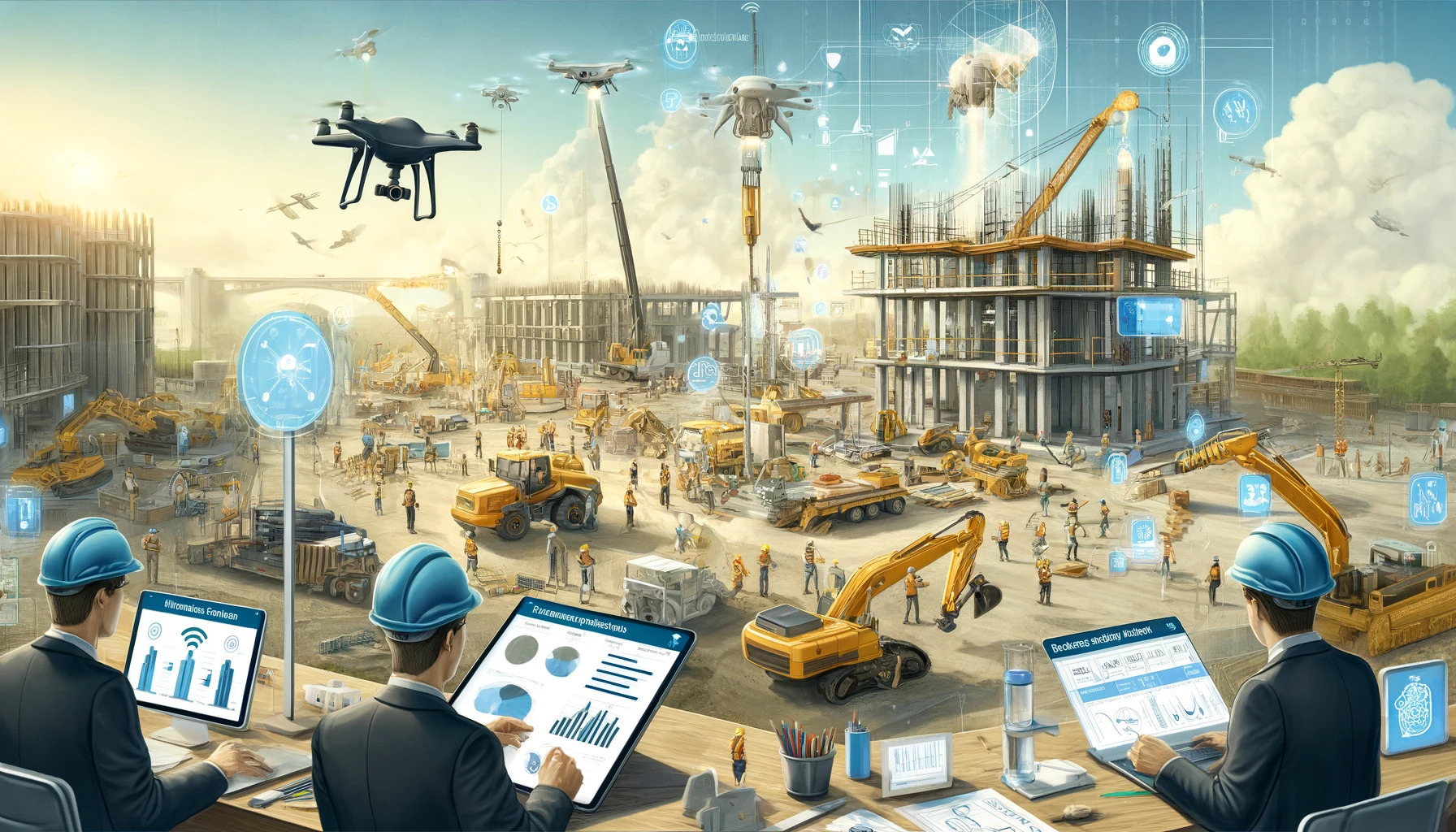Imagine a construction site where decisions are made with the precision of a chess grandmaster and the foresight of a weather forecaster. By integrating Artificial Intelligence (AI) and Large Language Models (LLMs), construction projects can achieve new heights of efficiency and significantly enhanced safety measures.
AI and LLMs in construction are akin to having a superpowered team member: they predict potential issues before they arise, optimise workflows, and ensure communication is clear and effective across all levels of a project. This blog will explore how these technologies are not just tools but game-changers in building safer, more efficient, and cost-effective structures.
The Rise of AI and LLMs in Construction
- Understanding AI and LLMs
AI in construction involves the use of machines that can perform tasks typically requiring human intelligence. These include planning, recognising patterns, and making decisions. LLMs, a subset of AI, focus on understanding and generating human language, helping to bridge communication gaps in complex projects.
- Enhancing Project Efficiency with AI
AI applications in construction range from automated machinery that can predict maintenance needs to software that optimises resource allocation and project timelines. For instance, AI-powered project management tools can predict delays or budget overruns by analysing data from ongoing activities and external factors like weather conditions.
- Boosting Safety on Construction Sites
Safety is paramount in construction, and AI significantly mitigates risks. AI-enabled monitoring systems can predict and prevent workplace accidents by analysing video feeds in real-time to detect unsafe behaviour or conditions. Additionally, wearable AI devices can monitor workers’ health signs, alerting supervisors to fatigue or other health concerns that increase the risk of accidents.
“Incorporating AI and LLMs into construction not only streamlines operations but fundamentally transforms how we approach safety and efficiency on the job site,” says Alex Johnson, a construction technology expert.
Transformative Technologies: AI and LLMs at Work
- AI in Design and Preconstruction
AI technologies significantly enhance the planning and design phases of construction projects. Using Building Information Modelling (BIM) software integrated with AI, architects and engineers can create more accurate and detailed project models. These AI-enhanced models predict potential structural issues and automatically adjust designs to optimise material usage and cost.
- AI-Driven Structural Analysis
A notable example involves a major construction firm in Japan that implemented AI to perform structural analysis during the design phase. The AI system provided insights that reduced material costs by 20% and cut design time in half by identifying efficient construction methods and materials early in the process.
- LLMs Enhancing Communication
LLMs play a critical role in improving communication across diverse project teams. They can translate technical documents and regulations into multiple languages in real-time, ensuring that all team members understand project details and safety protocols, regardless of their native language.
- Improving On-Site Coordination with AI
AI also revolutionises on-site project management and coordination. Through the use of AI-powered tools, project managers can track real-time progress against the project plan. These tools analyse data from connected devices on-site to alert managers about potential delays or resource needs, allowing for immediate adjustments.
Integration Challenges and Future Potential
- Navigating Integration Challenges
Integrating AI and LLMs into existing construction processes isn’t without its challenges. The initial investment in technology can be significant, and there may be resistance from workforce members accustomed to traditional methods. Furthermore, training employees to effectively use these new tools requires time and resources.
- Potential for Future Growth
Despite these challenges, the potential for AI and LLMs in construction is vast. As these technologies continue to evolve, they could lead to fully automated construction sites where AI-driven robots and drones perform tasks, drastically reducing the need for human intervention in dangerous activities and further enhancing safety and efficiency.
“The future of construction lies in our ability to integrate advanced AI and language processing technologies, transforming every phase of project execution,” remarks Maria Gonzalez, a construction industry futurist.
Expert Predictions and Preparing for the Future
- Expert Predictions for AI and LLMs in Construction
As AI and LLM technology continues to mature, experts predict a significant shift towards more autonomous construction sites. AI is expected to manage not only routine tasks but also complex decision-making processes, leading to nearly fully automated construction projects. These advancements will likely reduce project timelines and costs while increasing precision and safety.
- The Role of LLMs in Future Legal and Regulatory Compliance
LLMs will become increasingly important in navigating the complex legal landscape of construction. They will be used to interpret and apply international building codes and regulations quickly, ensuring compliance and reducing the risk of costly legal issues.
Quote: “As we look forward, AI will not just support human workers but will eventually lead construction projects, offering unprecedented levels of efficiency and risk management,” states Dr. Helen Wright, an AI technology consultant in the construction sector.
Preparing for AI and LLM Adoption in Construction
- Developing a Technology Integration Strategy
To successfully integrate AI and LLMs, construction companies must develop a clear technology adoption strategy. This involves assessing current workflows, identifying areas where AI can have the highest impact, and setting realistic timelines for technology rollout.
- Investing in Employee Training and Change Management
One of the key challenges in adopting AI in construction is workforce adaptation. Investing in comprehensive training programs and change management strategies is crucial to help staff transition to new ways of working with AI. This not only enhances efficiency but also alleviates employee concerns about job displacement.
- Building Partnerships with AI Technology Providers
Establishing partnerships with technology providers can provide construction companies with access to the latest AI tools and expertise. These partnerships are essential for staying on the cutting edge of technology developments and ensuring that the solutions implemented are well-supported and effective.
Conclusion: Embracing AI in Retail
AI and LLMs are setting a new standard in construction. They enhance project efficiency, improve safety, and offer substantial cost savings through smarter resource management and decision-making. As the industry embraces these technologies, the way we build our future environments will continue to evolve, promising safer, faster, and more cost-effective construction practices.
Are you ready to harness the power of AI and LLMs to transform your construction projects? Contact BlueSky Creations today to explore how our innovative solutions can increase your project efficiency and safety. Visit our website at BlueSky Creations and take the first step towards a smarter, safer, and more efficient construction future.
FAQs
- What Are the Primary Benefits of AI in Construction?
The primary benefits of AI in construction include enhanced project efficiency through optimised scheduling and resource management, improved safety with proactive hazard detection and response, and increased cost-effectiveness by reducing waste and preventing overruns.
- How Can LLMs Improve Communication on Construction Sites?
LLMs improve communication on construction sites by providing real-time translation services, simplifying the interpretation of complex documents such as contracts and technical specifications, and facilitating clearer communication between diverse teams to avoid misunderstandings and delays.
- What Is Required to Integrate AI into Existing Construction Processes?
Integrating AI into existing construction processes requires a strategic approach that includes assessing technological needs, investing in suitable AI solutions, training staff to use new tools effectively, and establishing a supportive infrastructure for AI implementation.
- Are There Any Risks Associated with Using AI in Construction?
Yes, risks include potential data breaches, over-reliance on technology which might lead to skills degradation among workers, and initial high costs of implementation. Proper risk management strategies, continuous training, and robust cybersecurity measures are essential to mitigate these risks.
- How Can Construction Companies Keep Up with AI Advancements?
Construction companies can keep up with AI advancements by partnering with tech firms and AI solution providers, attending industry conferences, investing in continuous learning and development for their teams, and staying engaged with professional bodies that focus on technology in construction.
- What Is the Future Outlook for AI and LLMs in Construction?
The future outlook for AI and LLMs in construction is highly positive, with ongoing advancements expected to lead to more autonomous construction sites, smarter material usage, and enhanced regulatory compliance. As these technologies mature, they will become integral to all phases of construction projects.







No comment yet, add your voice below!